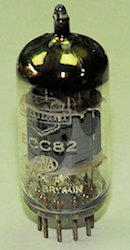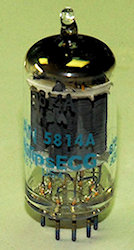To be or not to be ...
3 minute read
April 2020
Here is a piece that I was convinced that I had already written but it would appear not, and that I merely shared my musings with a friend via email. It concerns the humble ECC82, 12AU7 or JAN-5814A... and why the JAN-5963 is not a direct replacement.
Back in November last year, 2019, whilst testing a cosmetically beautiful Collins R-390A which I had obtained on behalf of a client, my tests revealed a couple of seriously ‘iffy’ 6AK5s and one under-performing 5814A in the calibrator. I found a couple of ‘good’ 6AK5s in my valve cabinet along with three brand-new 12AU7s ... or so I thought.



However, the latter turned out to be 5963s. The boxes were clearly marked JAN-5963 with 12AU7 handwritten on the end. A quick check ‘on-line’ confirmed that the 5963 was definitely NOT equivalent to the 12AU7. So the question was ‘How did I end up with a box of these?
Another search ‘on-line’ answered my question. I found a well-respected seller advertising the JAN-5693 as a direct replacement for the 12AU7. My ‘go-to’ source of valve data is The National Valve Museum and sure enough, the JAN-5963 is anything but a direct replacement for the 12AU7.
‘The 5963 is a special quality double triode introduced in 1954 for use in computer and frequency divider circuits where the valve will spend much of its time cut off.’ The data sheet is most specific on this matter … and a Brimar advert describes the 5963 as a valve with industrial applications where it is ideal for use in electronic switches.
The second page of a ‘Tung-Sol’ data sheet may suggest how it might be used as a class-A audio amplifier. However under these conditions the maximum Anode voltage is a paltry 67.5V.
Further ‘on-line’ searches found several forums where audiophiles were discussing the use of the JAN-5963 as a replacement for the 12AU7. It is interesting to note that a couple of forum contributors had reported unsatisfactory results.
It is not difficult to see how some people might actually get excited with the prospect of replacing their ECC82 or 12AU7 with something prefixed ‘JAN’ especially if the words ‘Class-A Amplifier’ appear in the data sheet. Firstly, the letters JAN tell us that the valve (or tube) was approved for (United States of America) Joint Army or Navy applications and there is every possibility, therefore, that such a valve is going to be of high, or special quality. Secondly, any amplifier operating in Class-A is going to be very linear … something that audiophiles are big on, since distortion levels will be extremely low.
So here it is… The ECC82 is a low gain general-purpose double triode used extensively in early television sets where it was employed in frame and line timebase multi-vibrators, AGC circuits and driver stages. Its relatively low amplification factor makes it ideal for applications where the gain can be tightly controlled.
The 12AU7 is simply a North American ECC82, and the JAN-5814A, used extensively in the Collins R-390 and 390A is simply a ruggedized version of the 12AU7.
The JAN-5963 was primarily designed to be used as a switch but can be used as a low gain Class-A amplifier provided the Anode volts are kept low … probably as low as 50V to be on the safe side.
Back in November last year, 2019, whilst testing a cosmetically beautiful Collins R-390A which I had obtained on behalf of a client, my tests revealed a couple of seriously ‘iffy’ 6AK5s and one under-performing 5814A in the calibrator. I found a couple of ‘good’ 6AK5s in my valve cabinet along with three brand-new 12AU7s ... or so I thought.

ECC82

JAN-5814A

JAN-5963
However, the latter turned out to be 5963s. The boxes were clearly marked JAN-5963 with 12AU7 handwritten on the end. A quick check ‘on-line’ confirmed that the 5963 was definitely NOT equivalent to the 12AU7. So the question was ‘How did I end up with a box of these?
‘The 5963 is a special quality double triode introduced in 1954 for use in computer and frequency divider circuits where the valve will spend much of its time cut off.’ The data sheet is most specific on this matter … and a Brimar advert describes the 5963 as a valve with industrial applications where it is ideal for use in electronic switches.
The second page of a ‘Tung-Sol’ data sheet may suggest how it might be used as a class-A audio amplifier. However under these conditions the maximum Anode voltage is a paltry 67.5V.
Further ‘on-line’ searches found several forums where audiophiles were discussing the use of the JAN-5963 as a replacement for the 12AU7. It is interesting to note that a couple of forum contributors had reported unsatisfactory results.
It is not difficult to see how some people might actually get excited with the prospect of replacing their ECC82 or 12AU7 with something prefixed ‘JAN’ especially if the words ‘Class-A Amplifier’ appear in the data sheet. Firstly, the letters JAN tell us that the valve (or tube) was approved for (United States of America) Joint Army or Navy applications and there is every possibility, therefore, that such a valve is going to be of high, or special quality. Secondly, any amplifier operating in Class-A is going to be very linear … something that audiophiles are big on, since distortion levels will be extremely low.
So here it is… The ECC82 is a low gain general-purpose double triode used extensively in early television sets where it was employed in frame and line timebase multi-vibrators, AGC circuits and driver stages. Its relatively low amplification factor makes it ideal for applications where the gain can be tightly controlled.
The 12AU7 is simply a North American ECC82, and the JAN-5814A, used extensively in the Collins R-390 and 390A is simply a ruggedized version of the 12AU7.
The JAN-5963 was primarily designed to be used as a switch but can be used as a low gain Class-A amplifier provided the Anode volts are kept low … probably as low as 50V to be on the safe side.